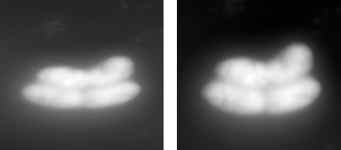FREQUENTLY ASKED QUESTIONS ABOUT ATOMIC FORCE MICROSCOPY (AFM FAQ)
AFM Artifacts
by Peter Eaton
2. Other Artifacts
Sample Drift
Sample drift just means that your sample is moving as you try to scan it in the AFM.
This artifact occurs in any type of SPM, or indeed any microscopy, but is much more serious in high resolution techniques
like SEM, TEM and AFM than optical microscopy.
It's known as "drift", because, in general, we see the sample moving slowly, in one direction (or expanding or contracting).
You can generally recognize this as a "distortion" of the image, which changes when you change the slow scan direction.
beginning of the image, and then the image will start to appear more normal over time.
The effect will be particularly pronounced if you move to a new place within your scan range.
See the example below.

In the example above, the two images of the same cluster of bacteria are not identical because the sample is moving while it is being scanned.
It is typical of this effect, that you will get different images in the two directions.
How to avoid it.
The best thing to do, is to stop your sample from moving.
The way to do this depends on why it's moving. Is it thermal expansion?
-then keep the temperature constant, turn off external sources of heat(lights), and wait for it to stop moving.
Trying fixing the sample down again, in any case.
The other way to overcome (or at least to reduce) the distortion is to scan quickly.
Artifacts Index Page
*************************************
This document was written by, and is maintained by Peter Eaton (peter.eaton@fc.up.pt)
Reproduction or distribution not allowed without my permission.
Please feel free to email me comments / questions / answers.
Document updated on 14th September 2007.

